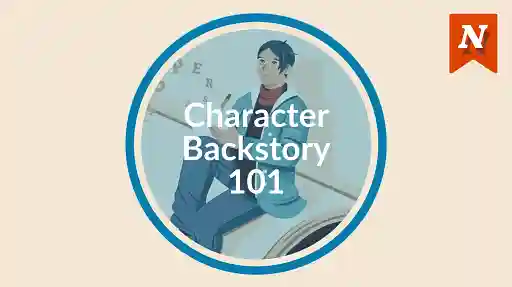Character motivations make characters' paths credible. When a character's behavior reveals their deeper drives, urges and impulses, they feel fully human. Read 6 questions that will help you work out characters' motivations:
1. What is their history or backstory?
Backstory is your character's history. Every person has a past. Our formative experiences shape our personalities to some extent. To start finding what drives your character, ask yourself questions about their background. For example:
- What kind of a childhood did they have?
- What were your character's hopes and dreams growing up?
- Which are the most significant events in their life leading to the point where the story starts?
Keep in mind these should be both the good and the bad events.
Backstory has its uses, but you need to be sparing with it. A story can get all too easily bogged down in backstory. You don't need to explain every action your character takes through past events in their life. But having an idea of these events will help you imagine what a character might do given a specific scenario.
An example of a book that uses backstory well is Thomas Harris' The Silence of the Lambs. The title refers to a traumatic event in the childhood of FBI Agent Clarice Starling. As a child, Starling heard the slaughter of lambs. This imbued her with sensitivity to the suffering of others. This aids her in her line of work as an FBI agent. The backstory we get is relevant to Starling's traits. Yet Harris also keeps backstory to a minimum. He gives us enough to help us understand Agent Starling, her personal strengths and weaknesses.
There are various approaches you can take to working out character motivations. You could write a brief imaginary biography for your character. This can take the form of a made-up Wikipedia entry. Or you could pretend they are a keynote speaker at an event. Write the blurb the MC could use to introduce your character. Use whatever creative approach works for you.
2. What does your character want?
Your character needs to want something more than anything else in the world. What your character wants should be simple without being simple to get. For example, your character may want true love. She might want to become a billionaire, or to rescue her kidnapped sister. She may want to escape an abusive husband, survive a sinking ship or any number of other things. Each of those examples, though, is fraught with possible setbacks and challenges.
The things characters want that drive their motivations should be specific and concrete. Then obstacles between your character and their heart's desire supply narrative tension.
Some genres supply us with character's desires by default. In a romantic novel, for example, the character wants the object of their affection. In a detective or crime novel, the investigator wants to solve the crime. When you have the desire supplying your character's motivations already, think about ways you can complicate these motivations.
For example, give your character flaws that get in their way. The romantic lead might have an unfortunately shy or stiff manner. It could come across as cold and disinterested to the love interest, for example. Jane Austen milks this character flaw for all it's worth in her classic novel Pride and Prejudice. Mr. Darcy's standoffish behaviour comes across as rude to Lizzie Bennett. We enjoy the narrative tension in Lizzie's gradual realization of Darcy's true nature. It is much kinder and more caring than first appears.
Brainstorm additional details about characters in the 'Character' section of Now Novel's step-by-step outlining tool.

3. What does your character fear?
Fear is a valuable emotion for building complex character motivations. Characters' fears supply the stakes for the story. A hero in a fantasy quest, for example, may fear failing their task. Or losing one of their companions in a skirmish.
One effect of fear is to help us focus. Take, for example, a performer suffering jitters and about to go on stage. Their only focus is nailing their performance. So how do your characters' fears focus their minds on their goals? A character who is afraid their lover might bore of them, for example, might go to extraordinary lengths to remain attractive.
Make a list of a character's possible fears and rank them from largest to smallest. What is their worst nightmare scenario? What do they do to keep the things they want to happen least (job loss, relationship loss, etc.) at bay?
Put characters' desires and fears in opposition to create tension
A great way to create riveting conflict is to make your characters' desires and fears compete.
Say, for example, a character wants to survive a sinking ship. They may also be terrified of water, knowing that they are a mediocre swimmer.
Another example: A character may want a lover. Yet emotional vulnerability frightens him. Characters' desires and fears don't always have to be at loggerheads. But fears can complicate motivations and give your characters interesting stumbling blocks.
4. What are your character's immediate and long-range goals?
So far we've spoken about goals and desires in abstract terms. But when telling a story, it helps to focus in each scene on two things:
- Characters' immediate goals in the scene: What does your character want to achieve in the course of the next few pages?
- Characters long-range goals: How does whatever your character will do next fit into their long-term objectives?
In a romantic novel, your character's immediate goal in a scene may be to find out more about an attractive stranger. Their long-range goal may be finding a fling for their summer abroad. Think about character motivations in terms of how they drive what happens next. This will help you invest each scene with purpose.
5. What dominant emotions drive your character?
When you brainstorm character's motivations, it helps to think about their dominant emotions. What are the primary emotions driving each character? Anger may drive some characters. Others have fear as their big driver. Others still may act from more virtuous emotions such as compassion and love.
A good story example where characters have clear dominant emotions is A. A. Milne's children's classic, Winnie the Pooh. In these stories, each character has a clear emotional make-up. Rabbit is anger personified. He's always irritable and bossing the others about. Piglet's main motivator is fear. Pooh always has an uphill battle dragging Piglet on adventures. Each character's primary emotional quality makes them distinctive and interesting. And they supply clear emotional motivations underlying their behaviour.

6. What are your character's primary and secondary motivations?
Most of the time, we're driven by more than one thing. A person who works all the time, for example, might have multiple underlying motivations. They may fear failure, desire success, and want to provide for their family.
As you brainstorm your characters, think about which are their main motivations. Which are their secondary ones? Is a detective's main drive to solve the crime professional? Or could there be a mingling of personal drives, as they've gotten to know the local community? Mixing professional and private motivations gives characters complex, interlinked drives. These push them to achieve their goals.
Work through the practical exercises in our workbook, How to Write Real Characters, and develop realistic and intriguing characters. Read more of our top posts on character creation in our character writing hub.









Character motivations for the bad guy are easier to come up with then the motivations of the protagonist, for me that is. I am working on an adventure novel and the bad guy want money and power, but to also return from exile to his homeland. It adds some nuance to their goals. The protagonist on the other hand is after treasure and the fame that comes with its discovery.
Jeremiah W Thomas - Almost 4 years ago
Not All Heroes Wear Capes, check out Your Everyday Heroes - Stories of people who are the living embodiment of inspiration. From mechanics to motivational speakers and everywhere in between. There is no shortage of astonishing and inspiring stories to be told!
Josh Daniels - About 3 years ago
Thanks for sharing, Josh, that sounds an inspiring project.
Jordan - About 3 years ago